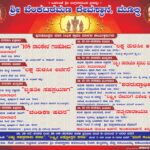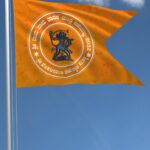Temple History
Volalanke: Mulki happened to be the capital of a small kingdom of Jain rulers called Savanths. Standing on the banks of river Shambhavi, close to the Arabian sea the town boasts of one of the most prominent temples of GSB community. On the eastern part of Mulki facing East is our Shri Venkataramana Temple located in an area called Vola-Lanke which if literally translated into English means the Inner Lanka. The presiding Lord of this Temple Lord Ugra Narasimha is popularly known as Volalanke Ugra Narasimha or Volalankadisha. Why is this place called as Volalanke ? The Sthala Purana says that Lord Hanuman on his way back carrying the mountain of herbs mistook this beautiful locality for Lanka and started descending. But soon he realised that this is not Lanka and therefore at once ascended and resumed his journey calling this as Volalanke. The word Mulki is actually derived from Moolikapura. Moolika – means medicinal herbs. This place was quite famous for the herbs and roots of medicinal properties prompting people to name it Moolikapura. People say that a few herbs had fallen here in Mulki from the mountain of herbs that Hanuman was carrying and hence the herbs and medicinal plants grew here.
Vittala Gudi:
The temple was originally consecrated as “Vittala Gudi”. On invitation from the Jain rulers 5 GSB families from Bhatkal came and settled in Mulki. The Vittala idol belonging to the Vatsa Gotra family was installed in a small temple and called as the Vittala Gudi. This is believed to be sometime in the 13th century. Later more families came and settled in Mulki and made it their home.
Lord Venkataramana from Padu Tirupathi:
Sometime in early 16th century (about 500 years back) because of some political upheavals in Karkala there was threat to the Shri Venkataramana Temple of Karkala. Karkala is famously known as Padu Tirupati. In order to protect their beloved Lord Venkataramana’s Idol the people of Karkala secretly carried the idols and hid them in a well in Mulki Vittala Gudi. After sometime when normalcy had returned at Karkala they came to Mulki to retrieve the idols from the well. But however much they tried they could not find the idols in the well. Much to the delight of Mulki people they could find the idols when they searched for it. Mulki people claimed that since Karkala people had not found the idols and they had found it – it shows that the Lord wants to stay back in Mulki. People from Karkala were very much disappointed and worried and did not know what to do. The Lord appeared in a dream to them and said that they should go back and one Sanyasi will give them an Idol of Lord in Karkala itself in a few days. People of Mulki happily consecrated the idol of Lord Venkataramana in the Vittala Gudi and the Vittala Gudi became – Shri Venkataramana Temple Mulki.
Lord Ugra Narasimha consecrated by Srimad Vijayeendra Thirtha Swamiji:

Lord Ugra Narasimha was consecrated in Mulki on Margashira Poornima by Srimad Vijayeendra Thirtha Swamiji. Swamiji found this beautiful awe inspiring idol of Ugra Narasimha in Kerala. There are couple of legends regarding how the Idol came into the possession of Srimad Vijayeendra Thirtha Swamiji. One version of says that this idol was found in a well along with other idols – Lord Venkatachalapathy of Cochin TTD. Another version mentions that this Idol was being worshipped at Varahapuram near Cochin in Kerala. Whatever be the case we are indeed fortunate that the Lord choose to come and stay here in Mulki and bless us all. We are forever indebted to Shrimad Vijayeendra Thirtha Swamiji. It must be mentioned here that Vijayeeendra Thirtha Swamiji had initiated into Sanyas Shri Yadavendra Thirtha Swamiji – the first pontif of Shree Kashi Mutt Samsthan.
Ugra Narasimha in Mulki is indeed unique in many respects:
- Lord is astha bhuja – 8 armed
- Lord is Trinetra – 3 eyed
- Lord is standing on one leg
- Lord is Ugra – he is depicted slaying the demon Hiranyakashipu with his nails (Nakhashtra). Usually Lord will be accompanied by either Goddess Lakshmi or Prahlad. Here they are not there.
- Lord is holding the intestines of Hiranyakashipu and wearing it as a garland.
- Lord has Brighu Lanchana on his chest
- Lord has a very beautiful Kamala – Nabhi Kamala
- Lord is holding Chakra in one of his right arms and Shankha in one of his left arms. The impression on sandalwood paste of the Chakra is given as Abhaya Hasta Prasdam in the Temple. This is usually worn by people in silver lockets for protection.
Lord Bindu Madhav from Varanasi
Lord Bindu Madhav is the Utsav Murti. This idol was found in the holy Ganga at Varanasi by Shri Madhavendra Thirtha Swamiji while they were having bath at the ghats. It must be noted that Lord Bindu Madhav is one of the main dieties of Varanasi. During the period of Shri Madhavendra Thirtha Swamiji the main idol of Kashi Lord Bindu Madhav was transfered to the Moola Mutt of Kashi Mutt for protection from the invaders. This idol must have been worshipped along with that.
Shri Madhavendra Thirtha Swamiji lovingly consecrated this idol at Shri Venkataramana Temple Mulki and designated it to be the Utsav Moorthi. It is Lord Bindu Madhav who partakes in all the Utsavs. Swamiji not only started the different Utsavs – Swamiji is credited with starting the Bramha Rathothsava on Ram Navami. Swamiji also got the Atri Gotra family of priests from Cochin and started the Pariyaya system between Vatsa Gotra and Atri gotra families.
It is again Shri Madhavendra Thirtha Swamiji whose time the famous Kal Bhairav oracle was started in the Temple. It is said that along with Lord Bindu Madhav the Brahma Rathothsav started and along with Rathothsav the Oracle of Kal Bhairav started. We are indeed fortunate that Shri Madhavendra Thirtha Swamiji blessed us with all these.







